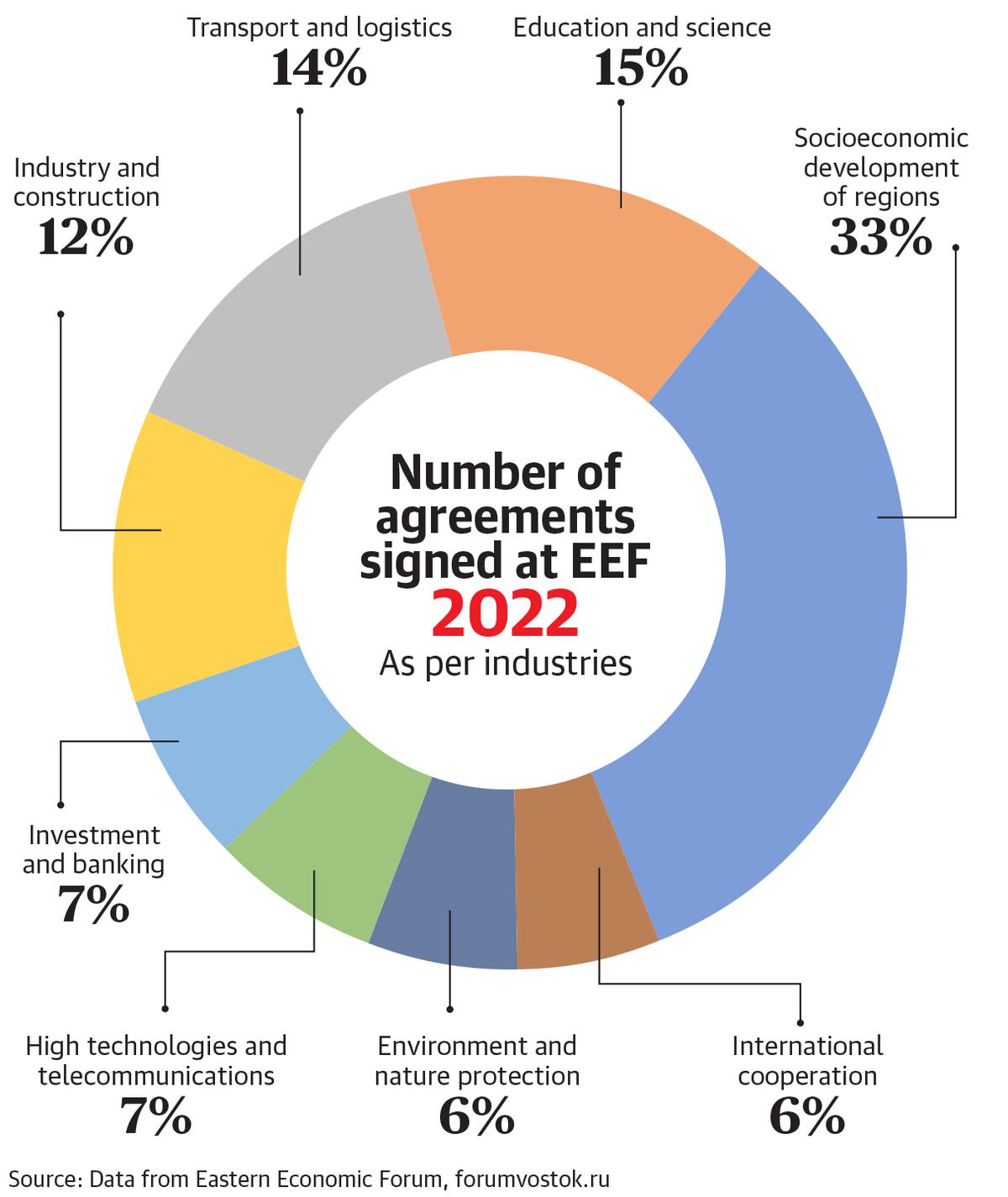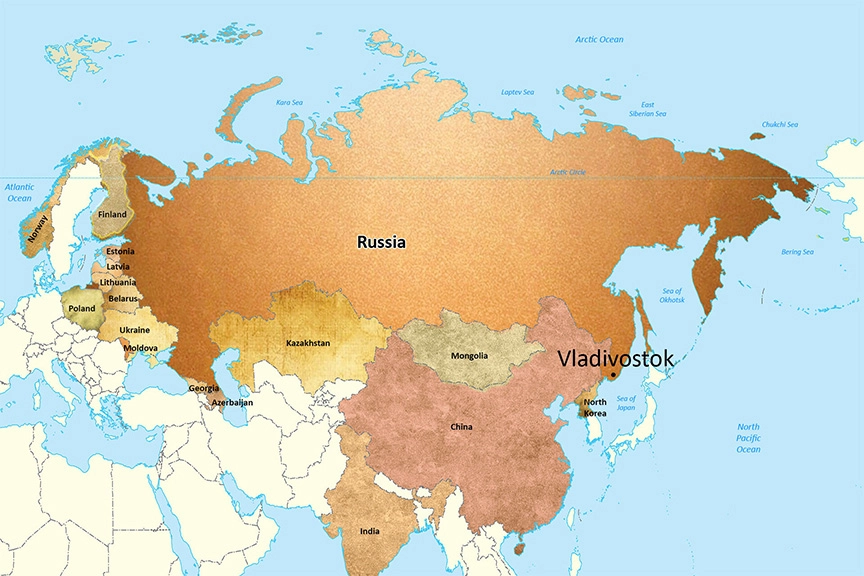Context
-
Russia hosted the seventh Eastern Economic Forum (EEF) Vladivostok. The four-day forum is a platform for entrepreneurs to expand their businesses into Russia’s Far East (RFE).
What is the Eastern Economic Forum?
- The EEF was established in 2015 to encourage foreign investments in the RFE.


- The EEF displays the economic potential, suitable business conditions and investment opportunities in the region.
- Agreements signed at the EEF increased from 217 in 2017 to 380 agreements in 2021, worth 3.6 trillion roubles.
- As of 2022, almost 2,729 investment projects are being planned in the region.
- The agreements focus on infrastructure, transportation projects, mineral excavations, construction, industry and agriculture.
Who are the major actors in the Forum? What are their interests?
- This year, the Forum aimed at connecting the Far East with the Asia Pacific region.
China
- The biggest investor in the region as it sees potential in promoting the Chinese Belt and Road Initiative and the Polar Sea Route in the RFE. China’s investments in the region account for 90% of the total investments.
- The Trans-Siberian Railway has further helped Russia and China in advancing trade ties.
- China is also looking to develop its Heilongjiang province which connects with the RFE.
- Connecting the cities of Blagoveshchensk and Heihe via a 1,080 metre bridge, supplying natural gas, and a rail bridge connecting the cities of Nizhneleninskoye and Tongjiang.
South Korea
- Invested in shipbuilding projects, manufacturing of electrical equipment, gas-liquefying plants, agricultural production and fisheries.
Japan
- In 2017, Japanese investments through 21 projects amounted to $16 billion.
- Identified eight areas of economic cooperation and pushed private businesses to invest in the development of the RFE.
- Seeks to depend on Russian oil and gas resources after the 2011 meltdown in Fukushima which led the government to pull out of nuclear energy.
- Sees a market for its agro-technologies which have the potential to flourish in the RFE, given similar climatic conditions.
- The trade ties between Japan and Russia are hindered by the Kuril Islands dispute as they are claimed by both countries.
India
- India seeks to expand its influence in the RFE.
- During the forum, Prime Minister expressed the country’s readiness in expanding trade, connectivity and investments in Russia.
- India is keen to deepen its cooperation in energy, pharmaceuticals, maritime connectivity, healthcare, tourism, the diamond industry and the Arctic.
- In 2019, India also offered a $1 billion line of credit to develop infrastructure in the region.
- India aims to establish a strong inter-state interaction with Russia.
- Business representatives of Gujarat and the Republic of Sakha have launched agreements in the diamond and pharmaceuticals industry.
What does the EEF aim for?
- The primary objective of the EEF is to increase the Foreign Direct Investments in the RFE.
- The region encompasses one-third of Russia’s territory and is rich with natural resources such as fish, oil, natural gas, wood, diamonds and other minerals.

- The sparse population living in the region is another factor for encouraging people to move and work in the Far East.
- The region’s riches and resources contribute to five per cent of Russia’s GDP. But despite the abundance and availability of materials, procuring and supplying them is an issue due to the unavailability of personnel.
- The RFE is geographically placed at a strategic location; acting as a gateway into Asia.
- The Russian government has strategically developed the region with the aim of connecting Russia to the Asian trading routes.
- With the fast modernisation of cities like Vladivostok, Khabarovsk, Ulan-Ude, Chita and more, the government aims to attract more investments in the region. Russia is trying to attract the Asian economies in investing and developing the far east.
- The Ukraine invasion is a worrying issue as it affects the economic growth of the country.
- However, Russia believes that it can survive the economic crisis and the sanctions with the help of China and other Asian powers.
- Although, the EEF is an annual gathering, the forum comes at an opportune time for Russia who is dealing with the impact of the sanctions.
- Moreover, the coming together of countries like Myanmar, Armenia, Russia, and China seems like the forming of an anti-sanctions group in the international order.
Will India be able to achieve a balance between the EEF and the Indo-Pacific Economic Framework for Prosperity (IPEF)?
- The U.S.-led Indo-Pacific Economic Framework for Prosperity (IPEF) and the EEF are incomparable based on its geographic coverage and the partnership with the host-countries. India has vested interests in both the forums and has worked towards balancing its involvement.
- India has not shied away from investing in the Russia-initiated EEF despite the current international conditions.
- At the same time, India has given its confirmation and acceptance to three of the four pillars in the IPEF. The country understands the benefits of being involved in the development in the RFE but it also perceives the IPEF as a vital platform to strengthen its presence in the Indo-Pacific region.
- The IPEF also presents an ideal opportunity for India to act in the region, without being part of the China-led Regional Comprehensive Economic Partnership or other regional grouping like the Comprehensive and Progressive Agreement for Trans-Pacific Partnership .
- The IPEF will also play a key role in building resilient supply chains.
- India’s participation in the forum will help in disengaging from supply chains that are dependent on China and will also make it a part of the global supply chain network.
- Additionally, the IPEF partners will act as new sources of raw material and other essential products, further reducing India’s reliance on China for raw materials. Although, India has refrained from full participation in the trade pillar of the IPEF, it does not signify an end to India’s role in the forum.
Source: TH
Visit Abhiyan PEDIA (One of the Most Followed / Recommended) for UPSC Revisions: Click Here
IAS Abhiyan is now on Telegram: Click on the Below link to Join our Channels to stay Updated
IAS Abhiyan Official: Click Here to Join
For UPSC Mains Value Edition (Facts, Quotes, Best Practices, Case Studies): Click Here to Join
